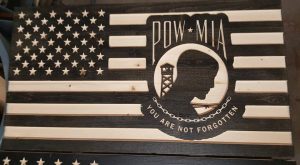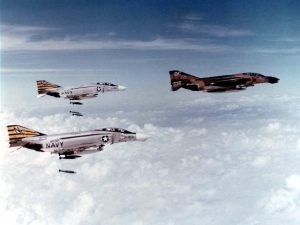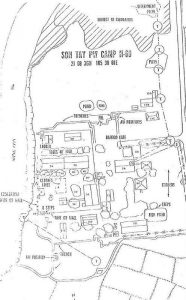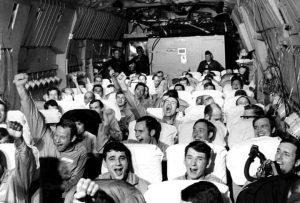In war, everyone loses. Participants sacrifice their lives, limbs and sanity; perpetrators their morality.
∼Joe Campolo Jr
War is the unfortunate endeavor which mankind seems intent on carrying out on a never-ending basis. Maybe we’re just too damn good at it. And one of the most unfortunate aspects of that unfortunate endeavor is the treatment and disposal of POWs; prisoners of war.
In the earliest of wars, which we humans have inflicted upon one another, prisoners were rarely taken. Anyone unfortunate enough to be caught by the enemy was usually killed; actually, tortured and then killed.
Over the ions, belligerents found that keeping captured enemy soldiers as prisoners served several important needs. It got the enemy soldier out of action, provided a possible source of enemy intelligence, gave the citizenry a physical entity to hate and vent on, and perhaps the best reason of all, it provided a bargaining chip, to be cashed in when needed.
By the time the Vietnam War rolled around, taking prisoners was a standard part of warfare. But how each belligerent used and treated the POWs they had captured varied widely, depending on circumstance. The U.S., a military powerhouse, had no need for any such bargaining chips in the Vietnam War, nor did they need any “bad guys” for it’s citizenry to vent anger and hatred at.
The North Vietnamese, however did. Badly outmatched regarding firepower, technology and manpower, they went after American POWs with a vengeance. Taking American GIs captive, and subjecting them to torture and depravation provided a bit of payback for the underdog in the race. It also gave the North Vietnamese citizenry, who had been subjected to many aerial bombardments, a taste of justice. And as we were to find out, it provided the North Vietnamese with a very large bargaining chip, which they used to full advantage.
Of the 766 American POWs captured during the war, (Ref Note 1) the vast majority were US Air Force, US Navy and U.S. Marine air crews. And of that group, 114 died in captivity. (Ref Note 2) As a U.S. serviceman in Vietnam from January of 1970 to January of 1971, I marveled at the fortitude of the air crews. Flying day and night in all kinds of weather, providing close support to ground troops and making bombing runs at low altitude in unknown, difficult terrain. The right stuff indeed.
US Air Force Phantom followed by two US Navy Phantoms in action over Vietnam
And the most dangerous missions were those over North Vietnam, where the aircraft were subjected to battles with MIGs and targeted by SAM missiles. U.S. Airmen rarely lost any battles to MIGs, but the SAMs were a different story. Aircrews that were shot down, were subjected to immense danger, many being killed or badly injured when their aircraft was hit, or when their parachutes malfunctioned or encountered bad terrain upon hitting the ground. After they did make it down, they were often targeted by hostile North Vietnamese citizens, along with various North Vietnamese militias. U.S. rescue teams in both South and North Vietnam distinguished themselves through heroic efforts in reclaiming downed air crews, but for those that couldn’t be rescued and survived, a long nightmarish journey lay ahead.
Thirteen prisons were employed by the North Vietnamese to incarcerate American POWs during the Vietnam War. Hoa Lo (Hanoi Hilton) in downtown Hanoi was the most infamous, however each of the thirteen had their own chamber of horrors which were visited upon the hapless captives of the various facilities.
Map of Son Tay prison camp
In November of 1970 elements of the US Air Force, U.S. Navy, and Central Intelligence Agency (CIA) conducted a rescue attempt at the Son Tay prison near Hanoi. The raid was planned and rehearsed for many months in advance, unfortunately the prisoners at Son Tay had been relocated a short time earlier and the rescue mission failed. But the bravery and effort of those involved did not go unnoticed, and even the North Vietnamese were impressed by the efficiency of the raid; intelligence failure aside. I was in Vietnam during the rescue attempt, and learned of the effort shortly after it had occurred. It was another disappointment, in a war full of disappointments.
Jubilant American POWs on the flight home
In 1973, after intense negotiations (backed up with threats) North Vietnam released the remaining American POWs. (Ref Note 3) I watched along with thousands of others the televised homecoming with joy, relief, anger and sadness. In the wars that followed (they always do) I held my breath hoping that another valiant group of Americans would not be subjected to the heinous treatment received by American POWs during the Vietnam War.
After the Vietnam War ended, many of the American POWs who returned, went on to achieve prominent success in life, including distinguished careers in business, law, politics and other endeavors. The stalwart nature and robust training of the men who flew those aircraft under dangerous skies and then survived years of torture in captivity, would not be denied.
***
Note 1. Total number of Americans held as POWs during the Vietnam War, were figures ranging from 766 to 1500 depending on status as possible MIAs (Missing in action) vs prisoners of war.
Note 2. Total number of Americans who died in captivity during the Vietnam War, were figures ranging from the North Vietnamese figure of 55, to the American figure of 114.
Note 3. U.S. POWs who returned alive from the Vietnam War.
https://www.dpaa.mil/portals/85/Documents/VietnamAccounting/pmsea_returnee.pdf




I enjoyed your story. It gave me the chills and brought back the anger that I often feel when remembering those times.
Thanks Rick, they were some tough times. Happy many of the surviving POWs have gone on to enjoy life.
So sad and tragic for those brave men. None of them came home unharmed physically or mentally, but at least some of them have enjoyed a relatively normal life after their POW horror. Thanks for another great article Joe.
Thanks Bob, I can’t imagine having to endure what the POWs went through.